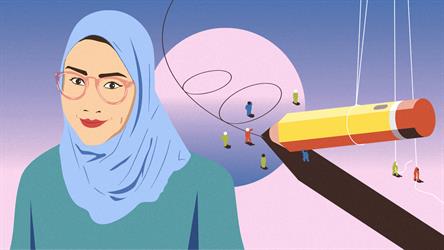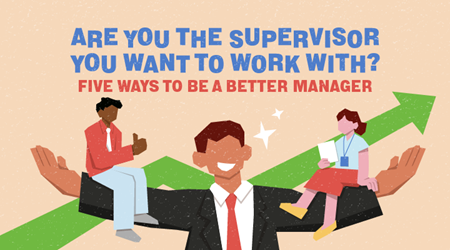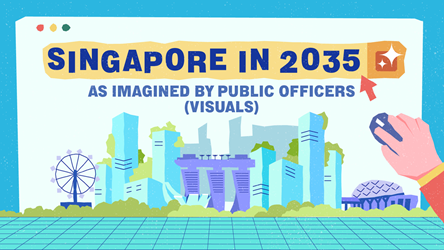Futurists Reveal Our Possible Future

Nearly 12 years ago, 2 airplanes crashed into the twin towers of the World Trade Center in New York City and changed the world forever. The unforeseen event led to two wars and a complete overhaul of airport security worldwide.
The September 11 terrorist attacks could be described as a “black swan”, a shocking outlier event with an extreme, world-changing impact that tends to be rationalised later on with the benefit of hindsight.
According to the 9/11 Commission Report, the events of September 11 might have been prevented. The Commission blamed the “failure of imagination” on the part of the American leadership to perceive the threat, and intelligence agencies’ poor collaboration to connect clues suggesting an impending attack on American soil.
While black swans like 9/11 and the Severe Acute Respiratory Syndrome (SARS) pandemic are impossible to predict, countries and organisations could be more prepared for the unknown by using strategic foresight – also known as futures thinking – to anticipate future possibilities.
Singapore first began using futures tools like scenario planning in the 1980s. The unit, incubated in the Ministry of Defence, generated narratives of the future so that planners could imagine how the world may evolve and what problems, challenges and opportunities could occur. Since then, several futures units have been established in ministries, with some 150 public officers engaged in futures work today.
You can call this small group of strategic foresight officers futurists, futures thinkers or foresight strategists, but never call them clairvoyants or describe their work as “crystal ball gazing”.
Their job is not to predict the future. Instead, futurists should seek to give the necessary input for decision-makers to come up with informed assessments, wrote former Head of Civil Service Peter Ho in Ethos, a Civil Service College publication, in 2010. These scenarios should change assumptions of how the world works and compel people to think differently. Good scenarios are those that facilitate better decisions, not better predictions, Mr Ho added.
Ms Cheryl Chung, a lead strategist at the Public Service Division’s Centre for Strategic Futures (CSF), points out that many governments, including Singapore’s, are inclined to think that things will continue to go well if they are going well today.
To counter that kind of thinking, futurists consider alternative future possibilities within a realistic time frame of five to 15 years ahead. “Too far ahead, we’ll have things like jet packs and flying cars that won’t be taken seriously,” says Mr Lee Chor Pharn, a deputy director at the Ministry of Trade and Industry (MTI) Futures Group.
Futures work begins with extensive reading to gather information on major trends, and also emerging strategic issues that may not appear critical now but could have a significant impact if they occur. These include food and energy crises, cyber-terrorism and human augmentation. (These trends were covered in the May/June 2011 issue of Challenge.)
With the abstract future yet to happen, futurists craft logical stories or scenarios to communicate these possibilities in highly visual forms such as concept maps, manga and illustrated videos.
Look from many angles

Consider the optical illusion of the old lady and the girl. “If all along, you only saw the old lady, you would be surprised to find another way of looking at the same picture,” muses Mr Chong Teng Sheng. Fortunately for Mr Chong (and MEWR), he is used to seeing things in alternative ways all at once. It helps that he reads widely on the environment and water resources. But he reaches for literature on organisational management, behavioural sciences, history and paradoxes too. “When you learn about history, it helps you reflect about the future. Paradoxes challenge conventional thinking.”
Mr Chong describes his work as encouraging communication between futurists and other experts to connect ideas. “Many scientific breakthroughs come from being able to find synergy between two totally different silos,” he says.
One of the emerging strategic issues that Mr Chong and his team is monitoring is the impact of nanotechnology on the environment and public health.
Nanotechnology is the manipulation of matter on a molecular scale (10 thousand times smaller than the width of a strand of human hair) to build microscopic materials like drugs, or devices like robots.
Nanotechnology has many beneficial uses in products such as cosmetics, cars and paint, as it can smoothen surfaces and make things waterproof. But international research and policies on the safe application of nanotechnology are still evolving and progressing.
“So far, under normal circumstances, there is no evidence of harm to human health and the environment but this doesn’t equate to evidence of no harm,” says Mr Chong. “Ideally, we should try to uncover as much of the unknowns about nanotechnology as possible so that we can reap its benefits safely.”
The rising east

MTI’s Mr Lee Chor Pharn points out that much of our current thinking about the future comes from the Anglo-Saxon world. Their strategic foresight think tanks are well established, and their findings, published in English, are more accessible.
But as Asia rises in prominence, “we need to do ourselves a service and understand the future from the Asian and Southeast Asian perspectives” for a more balanced world view, says Mr Lee, who considers South Korea and Singapore as forerunners in strategic foresight. The challenge now is to identify and connect with thinkers with an Asian perspective – a situation that may be helped with the emergence of futures think tanks in China and Japan.
At the Futures Group (FG), much of the work involves synthesizing and translating information from research and interviews into meaningful insights that the MTI can work on. The group has made available online (www.futures-group.net) all their articles and illustrated videos of their findings, with a Creative Commons license usage to encourage sharing and mixing of ideas.
Communicating ideas is important, says Mr Lee, as reaching out to people and “having more ‘eyes’ out there responding with their own ideas” helps FG to consider different views.
One trend FG is examining is the role of automation in tomorrow’s jobs. While blue-collar jobs are being taken over by robotics and mechanisation, increasingly, algorithms are doing the same with white-collar jobs.
Algorithms are clear, well-defined sets of rules often used in computer programmes to solve problems. The more they are used, the more accurate they are as they are programmed to “learn”.
For example, legal analysts in the ’70s used to help lawyers in their research – and in turn gain job experience – by examining millions of documents. These days, law firms can do the same by hiring a single senior lawyer to do the same job, with the help of algorithms.
This reduces the need for such mid-level, white-collar “routine” jobs. More worryingly, the middle rungs of the job ladder break when junior to middle-level workers do not get to learn from experience or their superiors.
On the other hand, two types of work not easily replaced by automation will be more highly valued. They are the jobs that require high-level, analytical skills; and personal service jobs that require empathy and human interaction, such as healthcare, beauty and childcare.
Speak truth to power
Foresight strategists are like court jesters, says Ms Cheryl Chung.
“Their role is to tell the truth or a contrarian view”, even if it risks falling on reluctant ears, she explains. “People are uncomfortable with this because nobody wants to be challenged, right? Especially if you’re saying that the world going forward may not look like the world that we are prepared for.”
As professional challengers of prevailing world views, Ms Chung and her team present their cases backed by meticulous desk research, expert interviews and inter-agency workshop discussions.
They also run FutureCraft workshops to familiarise public officers with futures tools and methods, such as scenario planning, and other skills like facilitation and communication techniques that are useful for futures work. As in-house trainers familiar with Singapore’s Public Service, they are able to share their own experience that public officers can relate to, unlike foreign experts.
And unlike policymakers, futurists do not and cannot look at just one issue for a long, sustained period of time. “You need to build up expertise quickly, get out and then go in again,” explains Ms Chung.
CSF, the central agency coordinating futures work in the Public Service, compiles a list of Emerging Strategic Issues (ESIs) to look out for. These are issues that have not become critical but would have significant impact if they were to occur. Futurists must therefore be prepared to have credible conversations with experts on these issues, which can be as many as 50.
CSF has also been examining possible challenges facing the Public Service in a project on the future of the Service. One trend that has emerged is the increased competition that the Service faces in offering meaningful careers to jobseekers.

Singapore’s largest employer has traditionally sold careers on the opportunity to serve the nation and improve lives. But now, it has to compete for new hires with non-governmental organisations and voluntary welfare entities, or even businesses with strong corporate social responsibility programmes.
At the same time, as the Public Service faces an increasingly diverse and demanding population that wants a greater say in decision-making, holding a government job may seem less appealing than before.
Backcasting to the future

The NSRC has two research units that perform futures analyses. The externally oriented Terrorism and Extremism Futures Group (TEFG) studies developments in terrorism and extremism, while the Domestic Security Mapping and Monitoring Group (DSMMG) maps challenges to domestic security.
TEFG looks at a range of issues related to extremism in various parts of the world, such as white supremacy, Islamist extremism, xenophobia and anarchism, to complement the work of security agencies. It examines these issues with widely-available information and tries to relate foreign developments to possible impact on Singapore.
To make sense of domestic security challenges, a “backcasting” process developed within NSRC is used. This involves imagining future negative events, called Feared Outcomes, and working backwards to identify the different factors that could lead up to these scenarios.
From repeated backcasting sessions since early 2012, DSMMG has compiled a concept map of 40 pathways representing various challenges to Singapore’s domestic security. “This helps us to think about what can happen down the road and get a sense of where we are in relation to the issues and outcomes,” says NSRC’s Mr Yeong Gah Hou.

Most of the NSRC’s work is hush-hush as they deal with security concerns but Mr Yeong highlighted one general issue on their radar – the rise of Gen i, today’s highly connected, tech-savvy teenagers who grow up immersed in social media and mobile devices.
For national security concerns, Gen i’s world view and value systems are critical, especially as they begin to form the bulk of Singapore’s population over the next 10 to 15 years. Their wide exposure to diverse cultures and attitudes raises the question of how Singaporean values and experiences can be transmitted to them.
“What happens if a riot erupts and members of our security forces are sympathetic to rioters or even actively aid the rioters?” Mr Yeong asks.
Hence, Gen i will not only shape Singapore society in the future but also determine the nation’s response to crises.
Walk backwards

“Futures work is like walking backwards down an unknown path,” says Mr Timothy Yap, an education planning officer who handles futures work as well.
This means a futurist may have a clear sight of past events in front of him (hindsight) but he won’t be able to see what’s ahead. Thus, to navigate, he would have to rely on different ‘senses’; in this case, different strategic foresight methods.
Keeping an eye on the present is also important as education today prepares students for tomorrow, he adds. Hence, futurists are part of the Ministry of Education’s (MOE) Corporate Planning Office where their work is “focused on what is important on the ground for our schools and teachers to prepare our students for the future.”
“Education work today [means] thinking about the future all the time, because modifying each part of the system affects every other part of the system,” says Mr Yap. For instance, in reviewing examinations to reduce excessive stress, MOE needs to be careful not to inadvertently introduce more stress in other areas such as Co-Curricular Activities.
Mr Yap shares that there are social, economic and demographic trends that intertwine with and affect education. One of them is the rising affluence of society in general. Children from more affluent households have more learning opportunities, such as tuition and enrichment activities outside school, from a younger age. For a child from a less wealthy household, the advantage gap widens at an early age, as a result.
“We want to make sure that education continues to be a fair enabler,” he says. That is why there is increased attention on quality, affordability and accessibility of pre-school education to close the gap as early and as much as possible. Also on the ministry’s to-do list is to maintain the public’s trust in the education system and its prestige, so that good teachers are attracted.

“The system lives and dies by its good teachers. How do you attract good teachers? Increasingly, the answer is not pay. How do we make it an attractive job, one that people want to take up and be involved in? And while we can attract good teachers today, how can we do so given the demand for talent across various sectors of our economy in the future?” says Mr Yap, of the questions that his futures team often asks itself.
Read more about the insights of futures thinkers from various Ministries in our May/June 2011 cover story, The 12 Trends That Will Affect You.
- POSTED ON
Jan 16, 2013
- TEXT BY
Siti Maziah Masramli
- PHOTOS BY
Justin Loh
-
Deep Dive
Strengthening Singapore’s Food Security
-
Deep Dive
An Imagined City: Singapore In 2035









